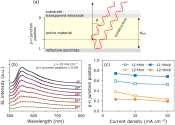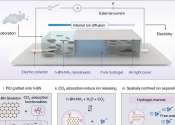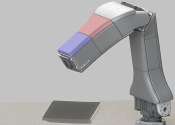Last update
Energy & Green Tech
Garbage could replace a quarter of petroleum-based jet fuel every year
Every year, the nation's aviation industry uses around 22 billion gallons of jet fuel, which produces about 1 billion tons of carbon dioxide—or 3% of the world's carbon dioxide emissions. Because of this, researchers and ...
56 minutes ago
1
4
Electronics & Semiconductors
Universal 'cocktail electrolyte' developed for 4.6 V ultra-stable fast charging of commercial lithium-ion batteries
Lithium-ion batteries (LIBs), mainly used as the power of computer, communication and consumer electronic products, require higher energy density, longer cycling life, faster-charging capability, and a broader operating temperature ...
2 minutes ago
0
0

For more open and equitable public discussions on social media, try 'meronymity'
Have you ever felt reluctant to share ideas during a meeting because you feared judgment from senior colleagues? You're not alone. Research has shown this pervasive issue can lead to a lack of diversity in public discourse, ...
2 hours ago
0
22

Mess is best: Disordered structure of battery-like devices improves performance
The energy density of supercapacitors—battery-like devices that can charge in seconds or a few minutes—can be improved by increasing the 'messiness' of their internal structure.
2 hours ago
0
39

An ink for 3D-printing flexible devices without mechanical joints
EPFL researchers are targeting the next generation of soft actuators and robots with an elastomer-based ink for 3D printing objects with locally changing mechanical properties, eliminating the need for cumbersome mechanical ...
3 hours ago
0
32
Robotics
Engineers design spider-like robot that may be used to explore caves on Mars
A team of roboticists and mechanical and aeronautical engineers at Stanford University has developed a spider-like robot for possible use in exploring caves or lava tubes on Mars. In their paper published in the journal Science ...
7 hours ago
0
29
Engineering
Floating solar's potential to support sustainable development
A study, published in Nature Energy, is among the first to explore the floating photovoltaics (FPV) at the continental scale, finding that FPV installed at existing major reservoirs could produce 20–100% of the electricity ...
4 hours ago
0
42
Electronics & Semiconductors

Harvesting vibrational energy from 'colored noise'
The energy demands of today's ubiquitous small electronic devices—including sensors, data transmitters, medical implants and 'wearable' consumer products such as Fitbits—can no longer be met by chemical batteries alone. ...
5 hours ago
0
16
Electronics & Semiconductors

New understanding of energy losses in emerging light source
The light-emitting electrochemical cell (LEC) can be fabricated in a sustainable and cost-effective way on both rigid and flexible surfaces making it suitable for a broad range of applications, like illumination, health care, ...
5 hours ago
0
41
Machine learning & AI

Meta's newest AI model beats some peers. But its amped-up AI agents are confusing Facebook users
Facebook parent Meta Platforms unveiled a new set of artificial intelligence systems Thursday that are powering what CEO Mark Zuckerberg calls "the most intelligent AI assistant that you can freely use."
3 hours ago
0
1
Robotics

Octopus inspires new suction mechanism for robots
A new robotic suction cup that can grasp rough, curved and heavy stone, has been developed by scientists at the University of Bristol. The team, based at Bristol Robotics Laboratory, studied the structures of octopus biological ...
6 hours ago
0
23
Electronics & Semiconductors

Proof-of-concept nanogenerator turns CO₂ into sustainable power
University of Queensland researchers have built a generator that absorbs carbon dioxide (CO2) to make electricity.
7 hours ago
1
72
Robotics

Using sim-to-real reinforcement learning to train robots to do simple tasks in broad environments
A team of roboticists at the University of California, Berkeley, reports that it is possible to train robots to do relatively simple tasks by using sim-to-real reinforcement learning to train them. In their study, published ...
Engineering

Clearing the air: Wind farms more land efficient than previously thought
Wind power is a source of energy that is both affordable and renewable. However, decision-makers have been reluctant to invest in wind energy due to a perception that wind farms require a lot of land compared to electric ...
23 hours ago
0
111
Robotics

How 3D printers can give robots a soft touch
Soft skin coverings and touch sensors have emerged as a promising feature for robots that are both safer and more intuitive for human interaction, but they are expensive and difficult to make. A recent study demonstrates ...
23 hours ago
0
25
Robotics

A rimless wheel robot that can reliably overcome steps
Robots with wheels could potentially navigate a variety of indoor and outdoor environments, traveling for longer distances and with fewer risks of losing balance. While some wheeled robots have achieved very promising results ...
Electronics & Semiconductors

Researchers use machine learning to create a fabric-based touch sensor
A new study from NC State University combines three-dimensional embroidery techniques with machine learning to create a fabric-based sensor that can control electronic devices through touch. The paper is published in the ...
Apr 17, 2024
0
22



















